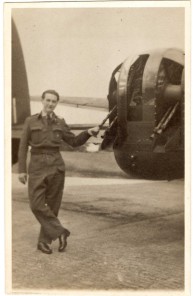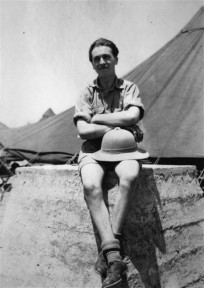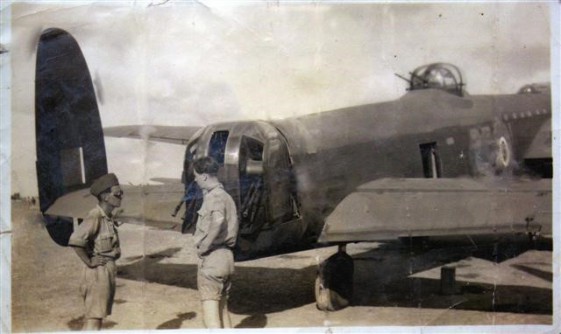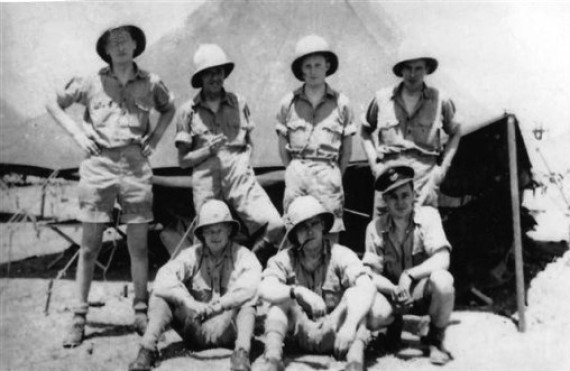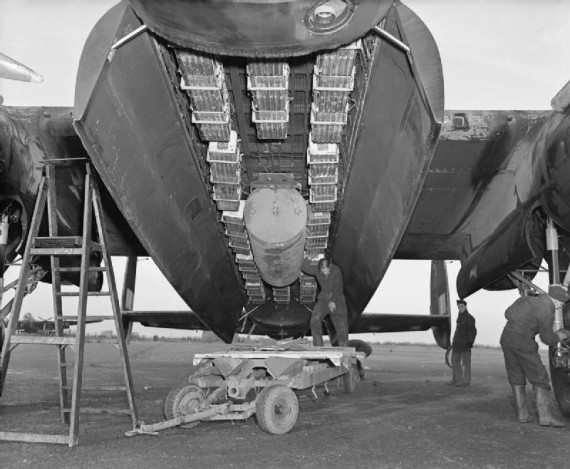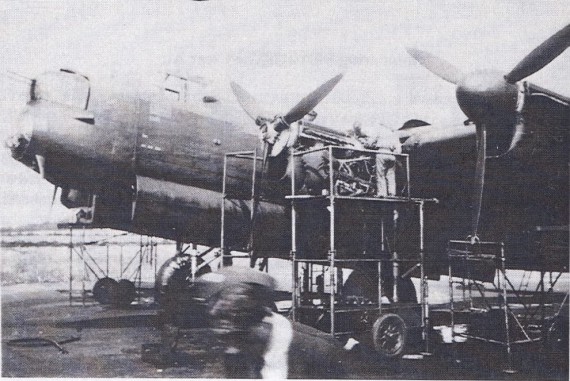Flight Sergeant Christopher Danby Towse
Early career
Known as Chris to the family, he was born on 6 June 1923 and worked on the family’s farm “Tufthill” in Kilham, near Driffield in East Yorkshire. On 25 March 1941, aged 17, he joined the RAFVR (Royal Air Force Volunteer Reserve) and received the service number 1237476. He was posted to No. 3 Reception Centre (Oxford?) on 30 September. Further training postings followed, then he went to the Aircrew Reception Centre (ACRC) at St Johns Wood on 2 June 1942.
On 6 June 1942 he was sent to ITW (Initial Training Wing) 14 at Bridlington – it must have been a stroke of luck to be so close to home on his birthday! His next posting on 12 July 1942 was to 2 AGS (Air Gunnery School) at RAF Dalcross (Inverness Airport). Next stop on 25 August 1942 was 25 OTU (Operational Training Unit) flying Wellingtons from RAF Finningley. On 1 December 1942 he went on to 1660 HCU (Heavy Conversion Unit) at RAF Swinderby.
On 31 December 1942 he was promoted to Sergeant, and was posted to his first operational unit, 61 Squadron at RAF Syerston, on 3 February 1943.
61 Squadron (motto – Thundering through the clear air)
(Derek Brammer wrote the squadron history – Thundering through the clear air – available from Amazon).
Chapter 5 of the book details the RAF history of “Nobby” Clark”, who was on the same crew as Chris. By then Chris was known as “Danny” and was qualified as a rear gunner. Nobby says they went together to No. 1660 HCU (Heavy Conversion Unit) at RAF Swinderby in January 1943, although Chris’ record card shows the posting on 1/12/43. Two crew were added to make the crew up to 7 for flying Lancasters.
Their first operational mission was in February 1943 and by June that year they had flown 25. The majority of their missions were during the “Battle of the Ruhr”, a 5-month campaign of strategic bombing during the Second World War against the Nazi Germany Ruhr Area, which had coke plants, steelworks, and 10 synthetic oil plants. The campaign bombed 26 major Combined Bomber Offensive targets. The targets included the Krupp armament works (Essen), the Nordstern synthetic-oil plant (Gelsenkirchen), and the Rheinmetal–Borsig plant in Düsseldorf.
They and four other crews carried out special training for “Operation Bellicose”. Bombers to Germany were suffering losses from night fighters which waited on their route home from where they bombed. “Shuttle bombing” was designed to avoid this, by flying on from Germany to stop over at Maison Blanche or Blida in Algeria, then bombing an oil depot at La Spezia in northern Italy before returning to base. None of the 120 aircraft that took part were lost.
Aircrew were required to do 30 missions to complete a tour, and Chris’ crew’s 30th was to bomb Gelsenkirchen in Germany on the night of 9/10 July 1943. The aircraft was hit by flak and Bob Dyson, the navigator, was hit by shrapnel and killed. The pilot flew the aircraft back to RAF Manston in north Kent, then back to Syerston the following day. As this was only Chris’ 27th mission, the crew must have flown three missions before he joined them. Their tour was declared as complete, and they were told that they would be posted to OTUs as instructors.
Bomb load Codes
Usual 1 x 4000lb Cookie plus 12 Small Bomb Carriers
(SBCs loaded with 24 x 30lb or 236 x 4lb incendiaries)
Arson 14 SBCs with incendiary mix up to a total weight of 14,000lbs
No Ball 1 x 4000lb Cookie plus 500lb or 1000lb GP (General Purpose)
Plumduff 1 x 4000lb Cookie plus 4 x 500lb and 12 x SBCs
Abnormal 8 x 1000lb GP
Gardening Air / sea mine laying, 5 x 1500lb mines
The list of known operations that Chris flew on is:
Date Target Bomb load
26/2/43 Cologne Usual
Cologne was bombed by the RAF in 262 separate raids during the war. Early targets were specifically linked to military concentrations or industry supporting the German war effort. On 30/5/42 it received the first thousand bomber raid.
27/2/43 East Friesians Gardening
4/3/43 Kattegat Gardening
“Gardening” was a euphemism for laying parachute mines in German shipping channels.
22/3/43 St Nazaire Arson
29/3/43 Berlin Usual
Berlin, the capital of Nazi Germany, was subject to 363 air raids during the Second World War. It was bombed by the RAF Bomber Command between 1940 and 1945, by the USAAF Eighth Air Force between 1943 and 1945, and the French Air Force between 1944 and 1945 as part of the Allied campaign of strategic bombing of Germany. It was also attacked by aircraft of the Red Air Force, especially in 1945 as Soviet forces closed on the city. British bombers dropped 45,517 tons of bombs; the Americans dropped 23,000 tons. As the bombings continued more and more people moved out. By May 1945, 1.7 million people (40% of the population) had fled.
3/4/43 Essen, Krupp factory Usual
The Ruhr Valley, sardonically known by aircrew as “Happy Valley” was the industrial heartland of Germany, and it included the Krupp armament works.
4/4/43 Kiel Usual
Kiel is an important port city at the Baltic Sea end of a canal which links the North Sea and the Baltic, saving 250 nautical miles by not passing around the Jutland peninsula.
8/4/43 Duisburg Usual
9/4/43 Duisburg Usual
Duisburg was a major logistical centre in the Ruhr area and location of chemical, steel and iron industries
11/4/43 Bay of Biscay Gardening
13/4/43 La Spezia Usual
La Spezia was and is an important Italian naval and commercial port, with oil refineries.
14/4/43 Stuttgart Abnormal
Nicknamed the "German Coventry," Stuttgart was an important rail hub and a centre of industry, home to the Bosch, Daimler-Benz, and the SKF ball bearings factories
16/4/43 Skoda works, Pilsen No Ball
After the German invasion of Czechoslovakia, the Skoda factory turned out arms for the Third Reich in quantity. On the night of 16 April 1943, Arthur “Bomber” Harris (Air Officer Commanding-in-Chief of Bomber Command) sent out more than 300 Lancasters to make the long flight to Pilsen.
Since the target was far beyond the range of Oboe, (a blind bombing targeting system based on radio transponder technology) the attack used H2S. This was the first airborne, ground scanning radar system. The H2S operators mistook the town of Dobrany for Pilsen (a 12-mile error) and a large mental hospital for the Skoda Works. The bombers dropped 691 tons of bombs and lost 36 aircraft, more than 12 percent of the attacking force.
20/4/43 Stettin Usual
Stettin in Germany (later Szczecin in Poland after 1945) was a major centre of weapons industry (including the car production Stoewer). 65% of Stettin's buildings and almost all of the city centre, seaport, and industry were destroyed during Allied air raids, and heavy fighting between the German and Soviet armies.
4/5/43 Dortmund Usual
596 aircraft took part in the first major attack on Dortmund, an industrial and communications centre in the Ruhr Valley.
12/5/43 Duisburg Abnormal
13/5/43 Skoda works, Pilsen No Ball
On this second raid 150 bombers correctly identified the target but landed almost all their bombs in a field outside the plant.
23/5/43 Dortmund Usual
826 bombers raided Dortmund, dropping 2,000 tons of HE and incendiary bombs in an hour. The Hoesch steelworks "ceased production", and 37,000 people were left homeless. Dortmund defences were said to have been caught completely unprepared, partly because one-quarter of its air raid defence workers had been shifted to rescue work in the area flooded by the RAF attacks on the Mohne and Eder dams one week earlier, in the famous “Dambusters” raid.
RAF loss was 4.8%.
25/5/43 Dusseldorf Usual
729 aircraft visited Düsseldorf. Two layers of cloud and decoy fires caused widely spread bombing. Hoesch steel and synthetic oil plants were targets. 26 bombers were lost.
27/5/43 Essen, Krupp factory Usual
518 bombers flew against Essen with 23 lost. Scattered bombing led to damage to parts of Essen and 10 other towns.
29/5/43 Wuppertal Usual
719 bombers attacked Wuppertal, another Ruhr town with factories supporting the German war effort. Oboe marking was used, and being relatively close to the UK, maximum payloads were carried. With only light defences, the bombing force was able to deliver their bombs accurately 1,000 acres (4.0 km2) of the old town burned down when a firestorm takes hold. "Five of the six major factories" were destroyed, as were the homes of 100,000.
11/6/43 Dusseldorf Plumduff
783 aircraft. Although initial marking was spot on for the first wave a backup marker Mosquito dropped target indicators 14 miles (23 km) off target to the north-east; with the effect that part of the bombing fell there. 130 acres (0.53 km2) of Düsseldorf were claimed as destroyed. 38 aircraft were lost.
12/6/43 Bochum Plumduff
This was another Ruhr industrial town, including the Bochumer Verein steel works, one of the largest steel plants in Germany. 503 aircraft attacked with targeting by Oboe sky marking. Severe damage to the centre of Bochum was caused. 24 aircraft were lost.
20/6/43 Friedrichshaven Usual (landed in Algeria)
Friedrichshafen is an industrial city on the northern shoreline of Lake Constance in Southern Germany, near both the borders of Switzerland and Austria. Targets included factories making aircraft, and tank engines and gearboxes. This was the outward leg of Operation Bellicose, a shuttle bombing raid. (See above)
23/6/43 La Spezia Abnormal (returned to Syerston)
The return leg of operation Bellicose.
25/6/43 Gelsenkirchen Plumduff
473 bombers unsuccessfully attacked the Nordstern synthetic-oil plant at Gelsenkirchen due to cloud and "unserviceable" equipment on 5 of the 12 Oboe-equipped Mosquitoes.
9/7/43 Gelsenkirchen Plumduff
418 bombers unsuccessfully attacked Gelsenkirchen - Oboe equipment failed to operate in 5 of the Mosquitoes and a 6th marked 10 miles (16 km) north of the target.
Their usual aircraft was Lancaster W4900, squadron code QR-Q Queenie, which flew 56 operations with Squadrons. After time on two conversion units, she was struck off charge (and presumably scrapped) in October 1945. Other aircraft they flew were W4934, lost on a Peenemunde raid on 17/8/43, and W5002, lost on a raid on Milan on 15/8/43.
Post operations
Chris and three of his crew were posted to No. 17 OTU on 23/7/43 at RAF Silverstone, training new recruits in Wellingtons. On 14 September they were informed that they had been awarded decorations for completing a successful tour – Chris got a DFM (Distinguished Flying Medal), which is believed to be with his family. It is recorded that Alf Mullins was presented with his medal by the King at Buckingham Palace, but for a reason unknown Chris’ medal was sent to his family in May 1945. This was his entry in the London Gazette, where decorations were announced: -
TOWSE, Christopher Danby, 1237476 Sergeant, No.61 Sqn. L.G. 14/9/1943 Sorties 27, Flying hours 171.50. Air Gunner. Air2/8979 Sergeant Towse has completed 27 successful sorties which include attacks on nearly every major German and Italian target. He has been ever watchful in his turret and his cool, lucid instruction combined with his offensive spirit has enabled his pilot to escape from many dangerous situations. On his last sortie, his aircraft was hit by flak over the target and the navigator killed. Sergeant Towse, by his calm in the emergency, set a fine example. 27th July 1943
This is what is known about the rest of his crew: -
Ward Clifford Parsons (Pilot) Came from Cayuga, Ontario, and joined the RCAF in June 1941. Trained as a pilot in Canada and graduated in February 1942. Post war, joined the British Overseas Airways Corporation (BOAC) as a commercial pilot, graduating to flying 747s before retiring in 1977. He passed away in 2000.
Fred Mullins (Flight Engineer) (Click the link for Fred Mullins story) Came from Bristol. Left the RAF in February 1946.
“Nobby” Clark (Wireless Operator) Came from Thorney, near Lincoln. Left the RAF in May 1946.
Bob Dyson (Navigator) Commissioned as Pilot Officer on 12/5/43. Killed in action on 10/7/44, aged 20. Son of Fred and Elsie Deborah Dyson, husband of Sheila Dorothy Ogilvie Dyson of Mill Hill. Buried in Hendon Cemetery.
“Frank” (Francis John) Poole (Bomb Aimer) 655599 Came from Weston-super-Mare. Like Chris Towse, he volunteered for a second tour and was posted to 83 Squadron. On 31/12/44 his crew were sent to bomb the German cruisers Emden and Koln in Oslo Fjord. They were shot down by a German night fighter and the aircraft crashed into the sea. Only one casualty was found and was buried in a local cemetery by the Norwegians. The remainder were declared missing, and Frank Poole is remembered on panel 269 of the Runnymede Memorial.
George Isaacs (Mid Upper Gunner) Came from Hornchurch, Essex. Remained at RAF Turweston with Nobby Clark until it closed down 1945, then went to RAF Silverstone. Presumably discharged from the RAF but no further information.
On 12/9/43 Chris was posted to No. 3 AGS (Air Gunnery School) at RAF Castle Kennedy in Scotland, then to 7 OTU at Limavady, to train Wellington crews for Coastal Command.
After a short spell in other OTUs he was posted to 83 Squadron on 24/3/44.
83 Squadron
Motto – “Strike to defend”.
Extract from the RAF’s squadron history:
“In April 1944, by which time it had also played its part in the Battle of Berlin, the squadron was transferred from No. 8 Group and Wyton to No. 5 Group and Coningsby. Up to this time all pathfinding had been done by No. 8 Group, but now No. 83 was to lead its old parent Group, No. 5, against separate targets. The squadron became concerned with attacks on railway targets in France, Belgium and Western Germany in preparation for the Allied invasion of the Continent and on the eve of the invasion - the night of 5/6th June 1944 - bombed gun emplacements at La Pernelle on the Normandy coast. On 8/9th June four of the squadron's Lancasters acted as a target illuminating force in the highly successful operation in which No. 617 Squadron, using 12,000-lb bombs or “Tallboys”, blocked the Saumur tunnel. “
I received the following information from Frankie Gee, whom I thank for checking the squadron records at the Public Records Office, and which gives some background on the crew’s formation. It also lists the raids they flew on before their crash.
“Rather surprised to see that the crew were not all posted into 83 together. Johnson, Brown and Read (spelt Reid on records) were posted on 19 March 1944, Meredith and Wheatley on 22 March and F/Eng. Sgt Young arrived on 30 March. They all came from Pathfinder Force Navigation Training Unit (PFFNTU) at Upwood. F/Sgt Towse also arrived on the 22nd from Foulsham. Lord knows what he was doing there because Foulsham was an active bomber station housing 192 Squadron; they were flying Halifaxes, Mosquitoes and Wellingtons Mk. X. I’m wondering if he knew Meredith and he was asked for specially. Just a thought and I might be wide of the mark, but why did Johnson the MUG (Mid Upper Gunner) go to PFFNTU and not the rear gunner?
Their first operation was on 11/12 April – they were then under the control of No. 8 Group and flew from Wyton. A few days later they went to Coningsby and No. 5 Group. The second operation was on 24/25 April to Munich, and their third was on 24/25 April to the explosives factory at St Medard-en-Jalles. They had to abandon this one because their starboard inner (engine) caught fire. Their fourth operation was to the same place and this time they had to circle the target for 42 minutes before they were instructed to bomb – not the best way to spend three quarters of an hour!
As you will see they were lost on their fifth operation. In the index to his 1944 losses, Bill Chorley shows Wheatley as being promoted to F.Lt. with the POW number 5109. Brown has the POW number 4899 and they were both in Stalag Luft Sagen and Baleria. Sgt Young has the number 3842 in Stalag Kopernikus. There are no details for W/Op Read.
“11/12th April 1944. 341 Lancasters and 11 Mosquitoes from1, 3, 5 and 8 Groups attacked Aachen. The raid was accurate and caused widespread damage and fires in the centre of Aachen and the southern part of the town, particularly in the suburb of Burtscheid. This was Aachen's most serious raid of the war. 11 Lancasters were lost. Hpt Helmut Bergmann of 111/NJG4 claimed 7 four-engined aircraft this night and Heinz-WolfgangSchnaufer of 1V/NJG1 claimed 2. No 83 Sqn put up seven aircraft to act as 'backers-up'. Two were lost. Lancaster ND389 (OL:A) piloted by P/O V.McConnell is believed to have been shot down by a night fighter. They crashed at Beersc (Antwerp) - all seven crew members were killed and Lancaster ND395 (OL:E) piloted by F/Lt P.F.Denny was hit by flak over Aachen. Only the Navigator survived to become a prisoner.
Lancaster ND494 (OL:S) piloted by F/Lt J.A.T.Meredith DFC with his crew
Sgt. RHC.Young (F/Eng), F/O RJH Wheatley RCAF (Nav), F/O G. Le
R Brown RCAF (B/A), F/O J S Read (W/Op), F/O H O Johnson DFC
(M/u/Gnr) and F/Sgt C D Towse DFM (R/Gnr) took off from Wyton at
20.48hrs carrying 13 x I000 medium capacity bombs. They bombed at
22.42hrs at 17,000ft at 160 knots and landed back at base at 00.24hrs on the
12th. At debriefing the crew reported that visibility was good and the first
T/Is (target indicators) were seen falling at 22.40hrs. Three more lots were seen to be going down before bombing but no green T/Is were seen. Concentration of the reds was good and incendiaries looked scattered. One lot went down early.
No 83 Sqn left Wyton on 18th April and went to Coningsby. On
the same day, no. 97 Sqn left Woodhall Spa and also went to Coningsby.
Both squadrons left No 8 Group and went to No 5 Group and acted together
as No 5 Groups 'markers' to the end of the war.
24th/25th April 1944. Whilst 637 aircraft went to Karlsruhe, 260 went to Munich. The marking and controlling worked well and accurate bombing fell in the centre of Munich. German reports detailed much damage, mostly of a public and domestic nature, none industrial but much damage was done to railway installations. Eleven Lancasters were lost, among these was ED649 (OLC) from No 83 Sqn piloted by FlO 1.B.G Pezaro, brought down by flak. All seven crew members were killed.
No 83 Sqn had put up 15 aircraft for the raid on Munich. Lancaster ND840
(OL:R) piloted by F/Lt J.A.T.Meredith, with his regular crew took off from
Coningsby at 20.47hrs carrying 6x4" cluster flares and I04x30lb incendiaries.
They bombed at 01.51 hrs from 17,500ft at 155 knots. Landed back at base at 07.15hrs on the 25th. At debriefing, the crew reported that they had 'planted' their bomb load right in the centre of a cluster of red TlIs. On arrival at the target, the flares were seen well concentrated. On leaving, a lot of incendiaries were seen well to the North West of the town. The attack appeared very good and well within the built-up area.
28th/29th April 1944. 88 Lancasters and 4 Mosquitoes from No 5
Group set out to attack an explosives factory at St Medard-En-Jalles near Bordeaux. Only 26 aircraft bombed the target. Because of haze and smoke
from fires in the woods near the factory, the Master Bomber ordered the
remainder of the force to retain their bombs and called off the attack. There
were no losses. No 83 Sqn had put up 15 aircraft. Lancaster JSI 80 (OLJ)
piloted by F/Lt J.A.T. Meredith DFC, with his regular crew took off from
Coningsby at 23.57hrs carrying 6 x 7" cluster flares and 6 x 1OOOlb medium
capacity bombs. The mission was abandoned 40 miles south of the start
point due to the starboard inner engine being on fire. The 6 x 1OOOlb bombs
were jettisoned 'live' at a point 4335W: 0348W at 0 I:10hrs from 6,000ft.
The starboard inner engine had caught fire at 00.II hrs and the fire went out
after 'feathering' . The 6 cluster flares and photo-flash were brought back.
Landed back at base at 03.29hrs.
29th/30th April 1944. 68 Lancasters and 5 Mosquitos of No 5 Group returned to the explosives factory at St Medard-En-Jalles and carried out concentrated bombing without loss. No 83 Sqn put up 14 aircraft. Lancaster ND840 (OL:A) piloted by F/Lt J.A.T.Meredith DFC with his regular crew took off from Coningsby at 23.58hrs carrying 6 x 7" cluster flares, 3x5" recce flares and 6 x 1OOOlb medium capacity bombs to act as 3rd wave reserve. Circled as ordered for 42 minutes then bombed as instructed at 02.38hrs from 7,000ft at 155 knots. Landed back at base at 06.04hrs,
bringing back their flares. At debriefing, the crew reported that this was a successful trip.
9th/10th May 1944. 56 Lancasters and 8 Mosquitos from No 5 Group set out to attack the Gnome & Rhone factory and another factory close by at Gennevilliers. A local report confirms the Bomber Command claim that both targets were hit, but 24 French people were killed and 107injured. Five Lancasters were lost. No 83 Sqn had put up 6 aircraft; among them was Lancaster ND494 (OL:G) piloted by FlLt J.A.T.Meredith with his regular crew. They took off from Coningsby at 22.28hrs and were hit by flak whilst flying low near Rouen. The pilot tried to gain height, but they were attacked by a night-fighter. With the starboard wing on fire they attempted to reach the Channel, but the Lancaster crashed. The pilot, F/Lt Meredith and his rear gunner F/Sgt C.D.Towse DFM were both killed, the Mid Upper Gunner, FlO H.O.Johnson DFC was badly injured and died the next day in a German field hospital. The Flight Engineer, Navigator, Bomb Aimer and W/Op were all taken prisoner.”
Last mission, 9/10 May 1944
A summary of their last mission is in the letter above.
The crew was:
Pilot F/Lt. JAT Meredith DFC 116987
Navigator F/O RJA Wheatley J16134 RCAF
Wireless operator F/O GS Read 155371
Flight Engineer Sgt. RH Young 1893287
Bomb Aimer F/O GL Brown J18354 RCAF
Mid Upper Gunner F/O HO Johnson DFC 112784
Rear Gunner F/Sgt. CD Towse DFM 1237476
Wheatley and Brown were Canadian; the rest were British.
Chris was killed by flak and the pilot on impact. Johnson was seriously injured and died the next day in a German field hospital.
The three casualties are buried side by side in a war graves section of the town cemetery in Evreux, the capital of Eure region.
Details of Lancasters used by the crew on operations
ND464 Built by A. V. Roe at their Chadderton plant. Into service in January 1944 with 405 Sqn and coded LQ:V then to No 83 Sqn in February 1944 and coded OL:S. On 16th July 1944, the aircraft, out on a night bombing practice flight suffered complete engine failure. Four crew members were able to bale out but the pilot FlO D.J. Hegerty DFC RAAF and two others were killed. The aircraft crashed 3 miles SE of Coningsby airfield.
ND840 Built by A. V. Roe at their Chadderton plant. Delivered to No 83 Sqn in April
1944 and coded OL:R. Transferred to No 97 Sqn in June and coded OF:J. Shot down by flak on a daylight raid to Rois de Cassano; 7 crew members were killed.
JB 180 Built by A.V, Roe at their Chadderton plant and delivered to 405 Sqn on 2nd September 1943. Transferred to No 83 Sqn in March 1944 and was coded OL:B at first, then OL:J and finally OL:T. Shot down over Wesseling on 21/22 June 1944. All seven crew members were killed. When she took off, this Lancaster had 426 flying hours to her credit.
ND494 Built by A.V. Roe at their Chadderton plant and delivered to No 83 Sqn In
January 1944. Among other targets, this aircraft had attacked Berlin twice,
Schweinfurt twice, Stuttgart and Leipzig. Lost on 9th/10th May 1944.
Gnome et Rhone, Gennevilliers
After the fall of France in 1940, Gnome et Rhone were ordered to switch aero engine production from their own radial designs to the BMW 801 for use in German aircraft. Gennevilliers is a River Seine port town to the north of Paris. The 9/10 May attack succeeded in destroying the foundry and stamping plant, where previous attacks had failed. Four other aircraft were lost during this raid; two from 106 Squadron and one each from 44 and 106 Squadrons. Casualties from the latter two aircraft are buried in the same row at Evreux as the three 83 Squadron losses.
I made contact with Wheatley’s widow Thelma Earl (he died in 1971 and she remarried), and one of her letters gives details of the crash and capture of the surviving crew. The transcript of this letter is:
“Dear Chris,
First my apologies for being so slow in answering your letter, I had the bad luck to have a bad fall & was lucky that nothing serious but really shook myself up & have been slow in getting back to normal. Add that to moving being a big deal – end of excuses.
To try to answer your questions – I “think” they were on their way home. I remember Dick saying that if Johnny (Meredith) hadn’t kept calm & did his best in bringing the aircraft down that they would all have been killed. I am sure that no-one parachuted – they were too low. On impact the plane broke in half. I knew that Johnny and one other were killed. I didn’t know about the third death.
Dick used to tell about how they climbed up the inside of the plane & down the outside. I think that there were four of them who started walking – then because they were very thirsty they stopped at a Catholic church & asked the priest for a drink of water – showing him a card they carried with French words & expressions on it. When the Germans caught up with them – surrounding them like in the movies – the first thing they asked for was the card with French expressions. They felt that the priest had turned them in and I’m afraid that Dick always held that against the Catholic church.
Dick was just starting his second tour, and this was only his second or third mission with 83 Squadron. He had known Johnny before & had spent leaves at his family home. At that time his father was a retired bank manager.
We kept in touch with the Merediths for about ten years then stopped hearing from them – I presume that they had passed away.
The rest of the crew I know nothing about, with the exception of Grant Brown whom I got to know after he returned, as I knew his wife as we grew up in the same city.
Hope this is some help. I’ve tried to locate the old address of the Merediths but no luck.
All the best, Sincerely, Thelma Earl
We are grateful to Chris Johnson a relative of Christopher Danby Towse for compiling the story of his flying career. A sad end to an illustrious career.
Mike Connock



